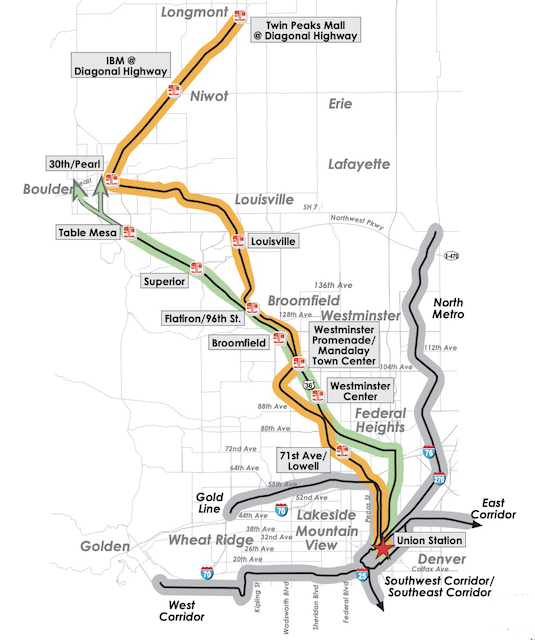Denver’s Regional Transportation District (RTD) has hired HDR to “study the feasibility of implementing a ‘peak service’ rail schedule between Denver Union Station and downtown Longmont.” HDR has never seen a rail project it didn’t think was feasible. Among other things, it lied to Atlanta, Cincinnati, Salt Lake City and several other cities about the economic development benefits of streetcars in order to get them to hire it to help build new streetcar lines.
 The green line is the existing bus-rapid transit line while the circuitous orange line is the proposed rail route to Longmont. The thick grey lines are other rail transit routes that are nearly all in service today. If Longmont were really a worthwhile destination, the logical thing for RTD to do is extend the bus-rapid transit line to Longmont. But Longmont officials were promised a train and they demand to have a train.
The green line is the existing bus-rapid transit line while the circuitous orange line is the proposed rail route to Longmont. The thick grey lines are other rail transit routes that are nearly all in service today. If Longmont were really a worthwhile destination, the logical thing for RTD to do is extend the bus-rapid transit line to Longmont. But Longmont officials were promised a train and they demand to have a train.
Now RTD wants it to study a commuter-rail line to Longmont, a city northwest of Denver. In 2004, RTD persuaded voters to approve FasTracks, a plan to build six new rail transit lines. One of those lines was to Longmont and RTD convinced Longmont officials to support the 2004 ballot measure by promising them a train.
After the election, cost overruns forced RTD to delay one of the lines. It picked the Longmont line because its own analysis found that each rider of that line would cost more than $60 but pay fares of less than $4.
When RTD first planned the Longmont line in 2001, it predicted it would cost $211 million to build. By the time voters approved the plan in 2004, projected costs had risen to $462 million. By 2008, costs had more than doubled to $897 million. The current estimate is $1.5 billion.
Since much of the line is duplicated by a bus-rapid transit route, it won’t attract many new passengers for all that money. In fact, the bus-rapid transit line was expected to carry close to twice as many passengers as the rail line. But the bus route terminates at Boulder and Longmont officials want the train they were promised.
RTD’s original plan called for building new tracks parallel to existing BNSF freight tracks. The subject of HDR’s feasibility study will be whether RTD could lease those BNSF tracks and run trains over them, thus saving much of the cost. But getting tracks that have been exclusively used by slow freight trains for more than 50 years into shape for passenger trains will still be costly.
RTD’s real motivation is the federal dollars for transit included in the infrastructure bill. As many a local official has said, “if there is federal money to be wasted, it might as well be wasted here.” Hiring HDR to do a study whose conclusion is foregone is just laying the groundwork for applying for some of those federal funds.








“OPM” Other peoples money syndrome.
Demand for transit service on the 15 miles between the 2 towns is so low RTD does not offer direct service between the two.
RTD has existing regional bus service Longmont – Denver but instead of going way west to Boulder as the proposed rail does, buses run straight south on U.S. Route 287 then hop on the bus rapid transit route at U.S. Route 36. It runs every hour on weekdays and the trip takes an hour. I’d be very surprised if a rail line trip from Longmont cutting way west to Boulder then back east to Denver would take less than an hour.
Planners have been kicking around making 287 a BRT too, which would speed travel from Longmont to Broomfield where buses pickup existing BRT on 36. This I think would make much more sense than a convoluted rail line and it could be extended up north to the Fort Collins/Loveland metro area.